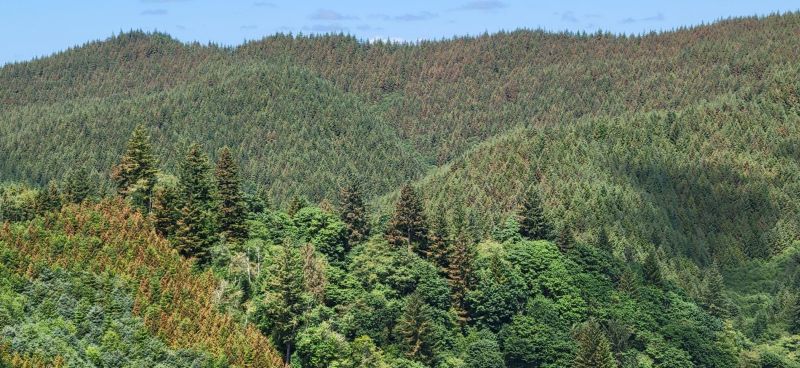
A group of scientists and forest managers at OSU and the US Forest Service are asking community members who experienced the June 2021 Pacific Northwest heat wave event to participate in foliage scorch research. Community members are invited to observe the heat impacts to foliage and report their observations using a website created by the Oregon Department of Forestry to survey drought impacts on forests.
Following two years of drought, many areas of the Pacific Northwest and British Columbia experienced unprecedented air temperatures during an extreme heat wave in late June and early July of 2021.
This event led to numerous reports of foliage scorch and leaf drop in westside forests of the Oregon coast range and the Cascades mountain range. Western hemlock (Tsuga heterophylla) and Western Red Cedar (Thuja plicata) seem to have been the most impacted tree species, but Douglas fir (Pseudotsuga menziesii) and various alder and maple species were also affected. Notably, trees and saplings with direct solar exposure and on south-facing slopes seemed to suffer the worst foliage scorch.
Researchers do not know what the near- and long-term physiological causes and consequences of foliage scorch and heat stress will be, at either leaf or tree scales. The impacts could range from impaired metabolism on surviving leaves to reduced stem diameter growth to eventual tree mortality. This event provides a unique opportunity to probe the physiological and ecological responses to an extreme heat wave in important tree species of the Pacific Northwest.
Researchers ask that anyone participating in the research please note in the “Description and/or caption information” of the survey that participants are reporting ‘impacts of the June 2021 heat wave‘ and also use the phrase ‘foliage scorch‘ so researchers can retrieve these observations later for mapping and analysis of this extreme event.


Foliage Scorch report for Logsden in Lincoln co Oregon. 70 acre west facing hillside with 30-70 year old Douglas-fir and red alder. The most visible effects are on the larger open grown fir with 10-30 % or the needles now red and dead. The red needles are mostly this years new growth. Also trees with Swiss needle cast had needle loss in last years growth. The scorch is on west side of trees that felt the late afternoon sun with temperatures of 108. Also impacted are red cedar and western hemlock. The 25 year old coastal redwood do not seem to be effected.
Thanks for your observations! Can you please fill out this survey: https://survey123.arcgis.com/share/b66ce6bd76144f4d91a000d61396554f
Yesterday I was driving back from Newport and observed significant foliage scorching for Douglas-fir along Highway 20. There appeared to be a gradient of impacts with the most severe foliage scorching nearest the ocean. As we drove more inland the degree of damage appears to decline, but this observation was made going 55 mph on the highway. It is interesting that I do not see the same impacts in the Valley and on my small tree farm although I am seeing significant drought damage. I am delighted to see this phenomena is being investigated as I had not seen anything in the newspapers and was planning to contact OSU about this event.
It may be instructive to compare heat damage to foliage caused by fires versus heat damage caused by extreme weather conditions.